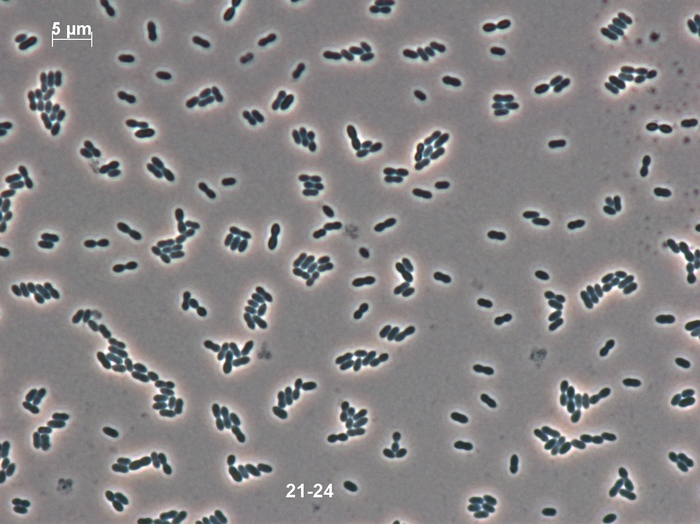A newly discovered species of antibiotic-resistant bacteria has been named after the academic institute where it was identified – the John Innes Centre.

Credit: DSMZ
A newly discovered species of antibiotic-resistant bacteria has been named after the academic institute where it was identified – the John Innes Centre.
Enterococcus innesii, was discovered by researchers investigating the gut microbiome of the Greater Wax Moth, Galleria mellonella. The moth is a pest of beehives and because it has a similar immune system to mammals is used as a scientific model to simulate the human gut.
Postgraduate researcher Harriet Gooch who discovered the new bacteria said: “It was a bit of a surprise because I wasn’t expecting to find a new species. Once I realised this was a new species of Enterococcus it made sense to name it after the research institute where I work.”
Researchers were working to isolate bacterial strains from colonies found in the digestive tracts of moth larvae. Harriet explains, “We were looking at what species were in the gut and what role they might be playing; it was known that the gut of Galleria mellonella larvae was generally dominated by enterococci but not always the same species. I wanted to see what bacteria were in the gut of the larvae I was using and what relevant genes they might have.”
Comparative whole-genome sequencing, coupled with observation of traits such as growth and metabolism, revealed the strain was an entirely new species within the Enterococcus genus.
Enterococcus innesii joins 59 species of enterococci already known to science, 14 of them discovered in the past five years.
Enterococci commonly cause hospital-acquired infections including two species, E. gallinarum and E. casseliflavus, which are closely related to E. innesii.
This discovery could have a significant research impact because experiments reveal that Enterococcus innesii has a gene that confers resistance to the antibiotic vancomycin, which may be unique to this species. Understanding how this gene is regulated may help future research into how the bacterium evolves resistance to antibiotics.
“We have found that E. innesii carries a gene that makes the bacterium resistant to the antibiotic vancomycin. This same gene has also been found in other species of Enterococcus that have been associated with human infections”, said Dr Raymond Kiu from the Quadram Institute. “This highlights the importance of ‘hunting’ for antibiotic resistance genes in a broader range of enterococci including those from environmental and animal sources.”
Vancomycin resistance is a growing issue when it comes to hospital-acquired Enterococcus infections. The research team say the new species may be a cause of hospital- acquired infections as it has genetic similarity to infective bacteria previously studied in the human gut.
Further work will focus on exploring how Galleria larvae and this new species along with other enterococci behave as commensals – biological relationships in which one party benefits but with no harm to the other.
This research is a collaboration between the John Innes Centre, Quadram Institute Bioscience, and Technical University of Munich.
Enterococcus innesii species isolated from the wax moth Galleria mellonella, appears in the International Journal of Systematic and Evolutionary Microbiology. https://www.microbiologyresearch.org/docserver/fulltext/ijsem/71/12/ijsem005168.pdf?expires=1640090348&id=id&accname=guest&checksum=534B7A5899C94B389146E1E6A2C9ECD0
Fact Sheet
-
Enteroccocus are a large genus of bacteria that are tolerant to many conditions and can be found in a wide range of habitats including fresh water, soil and as members of animal, human and plant microbial communities.
-
Vancomycin resistance is a growing issue when it comes to hospital- acquired Enterococcus infections.
-
Clinically some species are associated with opportunistic infections including bacteraemia, endocarditis and urinary tract and catheter infections.
-
Some species of Enterococcus have inherent resistance to many antimicrobial drugs, and they are also of concern because they can acquire more resistance traits to drugs too. Of particular concern are rising rates of vancomycin-resistant strains which are an increasing cause of infection in hospitals.
-
The Greater Wax Moth is known as a pest of beehives. In recent years its larvae have gained popularity as a model for understanding infection because they have a similar immune system to mammals.
-
The moths reduce the use of mice in research; they have a short life cycle and can be reared in the lab easily.
-
The John Innes Centre was named after its benefactor and founder, the London-property developer and philanthropist John Innes. Founded in 1910, the institute based at Norwich Research Park, is a world-leading centre for plant science and microbiology
Journal
INTERNATIONAL JOURNAL OF SYSTEMATIC AND EVOLUTIONARY MICROBIOLOGY
DOI
10.1099/ijsem.0.005168
Method of Research
Experimental study
Subject of Research
Animals
Article Title
Enterococcus innesii species isolated from the wax moth Galleria mellonella
Article Publication Date
17-Dec-2021




